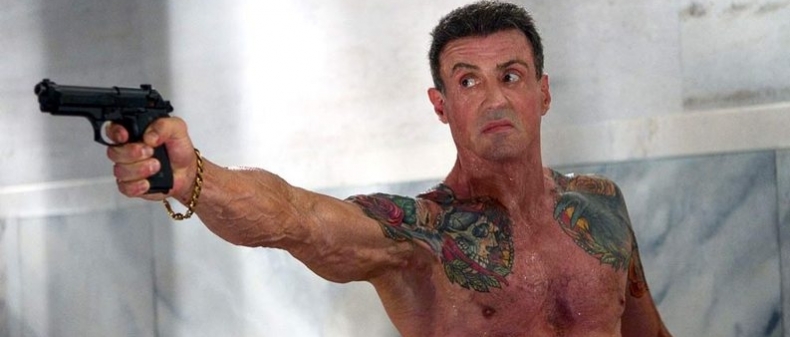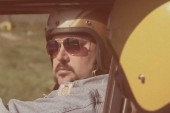
The trailer for Bullet To The Head, an upcoming Sylvester Stallone action vehicle, is pretty predictable stuff. Stallone — now 66 years old — plays an aging hitman who teams up with a young cop (Sung Kang) for One Last Job. Stallone is old, so his young sidekick cracks jokes about his age. In response, Stallone makes “harmless” jokes about his sidekick’s ethnicity (this time he’s Asian). These elements have been appearing in the films of aging action stars for a long time. In the Line of Fire saw Clint Eastwood lamenting about his old age to Rene Russo, his 24-years-junior love interest. Bruce Willis played the old white man to Mos Def’s young minority in 16 Blocks, Jean Claude Van Damme treated his entire career like one very sad joke in the excellent JCVD and a post-gubernatorial Arnold Schwarzenegger got into seniors-doing-young-people-things a couple weeks ago in The Last Stand.
The career of Sylvester Stallone, on the other hand, has defied this usual order of things. Stallone sunk to a nadir about ten years ago, and Bullet To The Head could be considered the first film to capitalize on the culmination of his decade-long comeback. His Planet Hollywood partners (Willis and Schwarzenegger) maintained a level of popularity that meant they didn’t really need to worry about their careers (or they went into politics). But in 2003, Stallone had resorted to making films in the same direct-to-video swamp that conquered the likes of Steven Seagal and Wesley Snipes, dishing out cheap thrillers with ill-conceived titles like Eye See You.
Instead of reinvigorating his career by teaming up with a younger star or “going back to his roots” as a real actor and doing an indie film (like he did a few years earlier in James Mangold’s Cop Land), Stallone managed to resurrect his career in the strangest way possible – he made further entries in franchises that had long turned into jokes, he wallowed in his past glories, and rather than referring to his old age in self-deprecating asides, he complained about it. Rather than allowing anyone else to play a role in his comeback, he directed his next three films himself and financed all of them outside of the Hollywood studio system. In what I like to call his meta-textual redemption trilogy, Rocky Balboa, Rambo, and The Expendables, Stallone emits a cry for help so sincere that it’s hard not to root for the guy. Say what you will about the quality of these three films, but Stallone makes a convincing underdog.
The first step of his comeback was 2006’s Rocky Balbao, his sixth time playing the role that made him famous. The story of the film — that a beaten, battered, nearly-60-year-old Rocky could return to the ring to face a reigning heavyweight champion — is thoroughly ridiculous, but Stallone invests the character with such feeling that it’s hard not to respect his effort. Gone is the Hollywood excess and ideological bombast of the previous sequels. Instead, Rocky Balboa is quiet and stripped down. Rocky wanders around Philadelphia, pays tribute to his now-dead wife Adrian, tries to reunite with his estranged son and laments the lost promise of his adulthood in his signature slurred monologues.
Somehow, this bizarre scenario comes together, partially because it can also act as a metaphor for the lost promise of Stallone’s career. In Rocky Balboa, the once-famous boxer makes a living by running a kitschy tourist restaurant that exists only to exploit his past accomplishments. The final fight in Rocky Balboa isn’t a grandiose spectacle that could end the Cold War, but rather a chance for Rocky to end his career with dignity. Likewise, Stallone began his career as an Oscar winner, but used his success to enter the world of Hollywood action stardom. In return Hollywood chewed him up and spit him out, forcing him to churn out pale imitations of past successes (his career has been thoroughly examined by Will Sloan over at Dork Shelf, if you so choose to enter that rabbit hole).
Stallone’s next film, the fourth entry in the Rambo franchise, follows the same formula — take a ridiculous concept and treat it with respect. Eschewing the politically charged locations of the previous sequels (Vietnam and Afghanistan, respectively), John Rambo ventures into war-torn Burma to save a group of Christian missionaries from the country’s despotic regime.
The style of the film matches Stallone’s grizzled visage — it’s all mud and blood and desturated greens; the copious amounts of violence are disturbingly graphic. It’s strange to think of this film as a “stripped down” version of anything, considering the title character kills nearly twice as many people as in the previous Rambo and that Stallone probably used human growth hormones to achieve his grotesque musculature, but Stallone treats his character’s PTSD and possible redemption with sincerity and avoids ironic posturing. Even Rambo’s anticipated mounting of a Gatling gun feels like a cathartic inevitability rather than an excessive spectacle. And once again, audiences are left with an affecting metaphor for Stallone’s career. Rambo begins the film in the wilderness of Thailand, but ends it at home, literally a farmhouse in the American Midwest.
By 2010, Stallone had no more dormant franchises to exploit, but after a decade of superhero flicks, Stallone could still count on lingering nostalgia for the uber-masculine actioners of the late 80s and early 90s. The Expendables‘ threadbare plot about a rogue CIA agent and a Latin American dictator wouldn’t be out of place in Stallone’s mid-career ouevre. To emphasize his inspiration, Stallone rounded out the cast with other has-beens, including Dolph Lundgren, Eric Roberts, and Mickey Rourke (Jean Claude Van Damme and Chuck Norris made it into the sequel).
While Stallone couldn’t resist the urge to insert a few self-referential jokes into this particular film (the cameos from Bruce Willis and Schwarzenegger are the worst offenders), he still made time for Mickey Rourke to deliver a bizarre, yet strangely emotional, three-minute monologue about a woman’s suicide and losing his soul: “We don’t stand for shit. We used to, but that dried all up.” Once again, Stallone offers a reason for his continued relevance: his soul hasn’t completely dried up, he can still redeem himself.
The Expendables was the last chapter in Stallone’ s trilogy of meta-textual redemption. For last year’s The Expendables 2, Stallone gave up the director’s chair to former Jerry Bruckheimer cohort Simon West, and the affecting career metaphors were traded in for increasingly grating in-jokes (including a cringe-inducing opportunity for awful human being Chuck Norris to recite Chuck Norris facts about himself).
Thus, Bullet To The Head is the culmination of Stallone’s late-career renaissance. It’s the first theatrical Stallone film to be marketed as a “Stallone film” — and not a coda to some bygone era — since 2001’s Driven. In general, the Aging Action Star is supposed to do the same death-defying stunts that he would do if he were younger, but now he has to crack jokes about social security benefits and grunt a little harder when something hurts. Bullet To The Head looks like this kind of film, but let’s not forget that it came on the back of three expensive vanity projects. Films that gutted the glories of Sylvester Stallone’s career but still demanded to be taken seriously. And somehow, they were.
____
Alan Jones is a Toronto-based writer whose work has appeared in Exclaim!, AV Club Toronto, and Toronto Standard. You can follow him on Twitter at @alanjonesxxxv
For more, follow us on Twitter at @torontostandard and subscribe to our Newsletter.













